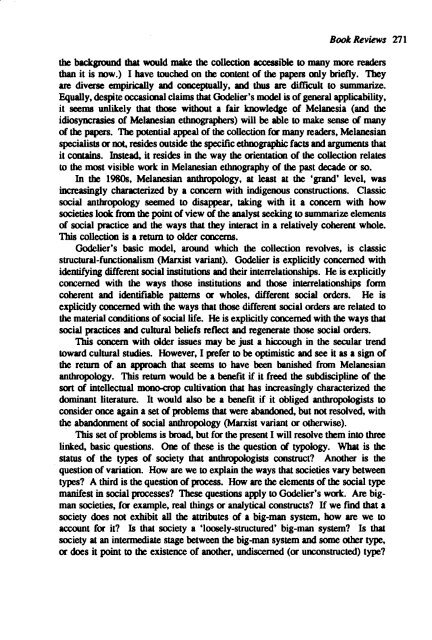1991 No. 1 CONTENTS - Institute of Social and Cultural ...
1991 No. 1 CONTENTS - Institute of Social and Cultural ...
1991 No. 1 CONTENTS - Institute of Social and Cultural ...
You also want an ePaper? Increase the reach of your titles
YUMPU automatically turns print PDFs into web optimized ePapers that Google loves.
Book. Reviews 271<br />
the background that would make the collection accessible to many more readers<br />
than it is now.) I have touched on the content <strong>of</strong> the papers ooly briefly. They<br />
are diverse empirically <strong>and</strong> conceptually, <strong>and</strong> thus are diffICUlt to summarize.<br />
Equally, despite occasiooal claims that Godelier's model is <strong>of</strong> general applicability,<br />
it seems unlikely that those without. a fair knowledge <strong>of</strong> Melanesia (<strong>and</strong> the<br />
idiosyncrasies <strong>of</strong> Melanesian ethnographers) will be able to make sense <strong>of</strong> many<br />
<strong>of</strong> the papers. The potential appeal <strong>of</strong> the collection for many readers, Melanesian<br />
specialists or not, resides outside the specific ethnographic facts <strong>and</strong> arguments that<br />
it contains. Instead, it resides in the way the orientation <strong>of</strong> the collection relates<br />
to the most visible work in Melanesian ethnography <strong>of</strong> the past decade or so.<br />
In the 1980s, Me1anesian anthropology, at least at the 'gr<strong>and</strong>' level, was<br />
increasingly characterized by a concern with indigenous constructions. Qassic<br />
social anthropology seemed to disappear, taking with it a concern with how<br />
societies look from the point <strong>of</strong> view <strong>of</strong> the analyst seeking to summarize elements<br />
<strong>of</strong> social practice <strong>and</strong> the ways that they interact in a relatively coherent whole.<br />
This collection is a retUrn to older coocems.<br />
Godelier's basic model, around which the collection revolVes, is classic<br />
structural-functionalism (Marxist variant). Godelier is explicitly concerned with<br />
identifying different social institutions <strong>and</strong> their interrelationships. He is explicitly<br />
concerned with the ways those institutions <strong>and</strong> those interrelationships form<br />
coherent <strong>and</strong> identifiable patterns or wholes, different social orders. He is<br />
explicitly concerned with the ways that those different social orders are related to<br />
the material cooditioos <strong>of</strong> social life. He is explicitly concerned with the ways that<br />
social practices <strong>and</strong> cultural beliefs reflect <strong>and</strong> regenerate those social orders.<br />
This concern with Older issues may be just a hiccough in the secular trend<br />
toward cultural studies. However, I prefer to be optimistic <strong>and</strong> see it as a sign <strong>of</strong><br />
the return <strong>of</strong> an approach that seems to have been banished from Melanesian<br />
anthropology. This return would be a benefit if it freed the subdiscipline <strong>of</strong> the<br />
sort <strong>of</strong> intellectual mono-crop cultivation that has increasingly characterized the<br />
dominant literature. It would also be a benefit if it obliged anthropologists to<br />
consider once again a set <strong>of</strong> problems that were ab<strong>and</strong>oned, but not resolved, with<br />
the ab<strong>and</strong>omnent <strong>of</strong> social anthropology (Marxist variant or otherwise).<br />
This set <strong>of</strong> problems is broad, but for the present I will resolve them into three<br />
linked, basic questions. One <strong>of</strong> these is the questioo <strong>of</strong> typology. What is the<br />
status <strong>of</strong> the types <strong>of</strong> society that anthropologists construct? Another is the<br />
question <strong>of</strong> variation. How are we to explain the ways that societies vary between<br />
types? A third is the question <strong>of</strong> process. How are the elements <strong>of</strong> the social type<br />
manifest in social processes? These questions apply to Godelier's work. Are bigman<br />
societies, for example, real things or analytical constructs? If we fmd that a<br />
society does not exhibit all the attributes <strong>of</strong> a big-man system, how are we to<br />
account for it? Is that society a 'loosely-structured' big-man system? Is that<br />
society at an intennediate stage between the big-man system <strong>and</strong> some other type,<br />
or does it point to the existence <strong>of</strong> another, undiscerned (or unconstructed) type?
















